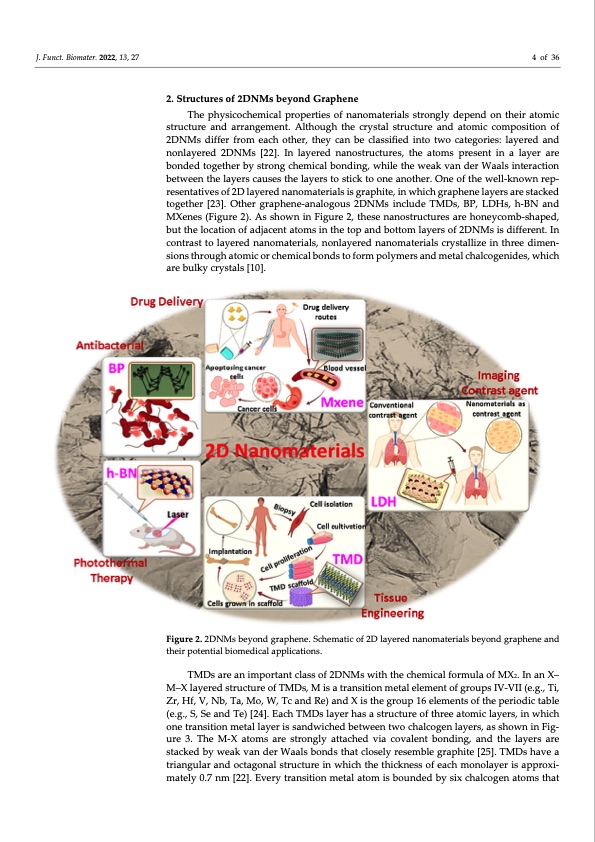
PDF Publication Title:
Text from PDF Page: 004
J. Funct. Biomater. 2022, 13, 27 4 of 36 2. Structures of 2DNMs beyond Graphene The physicochemical properties of nanomaterials strongly depend on their atomic structure and arrangement. Although the crystal structure and atomic composition of 2DNMs differ from each other, they can be classified into two categories: layered and nonlayered 2DNMs [22]. In layered nanostructures, the atoms present in a layer are bonded together by strong chemical bonding, while the weak van der Waals interaction between the layers causes the layers to stick to one another. One of the well-known rep- resentatives of 2D layered nanomaterials is graphite, in which graphene layers are stacked together [23]. Other graphene-analogous 2DNMs include TMDs, BP, LDHs, h-BN and MXenes (Figure 2). As shown in Figure 2, these nanostructures are honeycomb-shaped, but the location of adjacent atoms in the top and bottom layers of 2DNMs is different. In contrast to layered nanomaterials, nonlayered nanomaterials crystallize in three dimen- sions through atomic or chemical bonds to form polymers and metal chalcogenides, which are bulky crystals [10]. Figure 2. 2DNMs beyond graphene. Schematic of 2D layered nanomaterials beyond graphene and their potential biomedical applications. TMDs are an important class of 2DNMs with the chemical formula of MX2. In an X– M–X layered structure of TMDs, M is a transition metal element of groups IV-VII (e.g., Ti, Zr, Hf, V, Nb, Ta, Mo, W, Tc and Re) and X is the group 16 elements of the periodic table (e.g., S, Se and Te) [24]. Each TMDs layer has a structure of three atomic layers, in which one transition metal layer is sandwiched between two chalcogen layers, as shown in Fig- ure 3. The M-X atoms are strongly attached via covalent bonding, and the layers are stacked by weak van der Waals bonds that closely resemble graphite [25]. TMDs have a triangular and octagonal structure in which the thickness of each monolayer is approxi- mately 0.7 nm [22]. Every transition metal atom is bounded by six chalcogen atoms thatPDF Image | Nanomaterials beyond Graphene for Biomedical Applications

PDF Search Title:
Nanomaterials beyond Graphene for Biomedical ApplicationsOriginal File Name Searched:
jfb-13-00027.pdfDIY PDF Search: Google It | Yahoo | Bing
CO2 Organic Rankine Cycle Experimenter Platform The supercritical CO2 phase change system is both a heat pump and organic rankine cycle which can be used for those purposes and as a supercritical extractor for advanced subcritical and supercritical extraction technology. Uses include producing nanoparticles, precious metal CO2 extraction, lithium battery recycling, and other applications... More Info
Heat Pumps CO2 ORC Heat Pump System Platform More Info
| CONTACT TEL: 608-238-6001 Email: greg@infinityturbine.com | RSS | AMP |